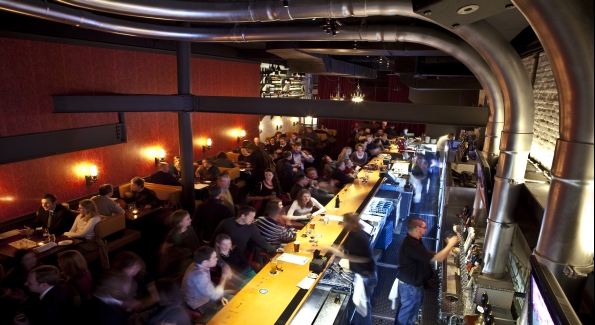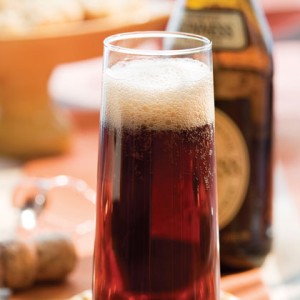On St. Patrick’s Day, wear green rather than drink it, and instead reach for a brew-based cocktail.
By Kelly A. Magyarics
Irish Car Bombs, Black and Tans, Irish Coffees and Picklebacks. Let’s face it: there is definitely no shortage of Irish drinks (authentic and otherwise) available on March 17. (In case you aren’t familiar with that last one, a “Pickleback” is a shot of Jameson Irish Whiskey followed by a shot of—you guessed it—pickle juice. And it just happens to be one of those bizarre combinations that just…works. I promise. Give it a try.)
I’m of proud Irish descent, and never turn down a creamy pint of Guinness, especially on my holiday. I also never, ever refuse a flute of any kind of sparkling wine. The festive solution to both on Shamrock Day is the Black Velvet. First created by the bartender of London’s Brook’s Club in 1861 to mourn the passing of Prince Albert, Queen Victoria’s Prince Consort, the Black Velvet is meant to symbolize the black or purple armbands worn by mourners. (Ok, so its origins aren’t exactly based in celebration and revelry, but if you casually forget that fact it’s a damn tasty drink.) The bubbles from Champagne or sparkling wine lighten the enticingly bitter taste of the stout. I always taste a touch of bitter chocolate when I drink Guinness, so if you happen to have on hand a bottle of Fee Brothers Chocolate Bitters, add a dash or two. And while you’re at it, you can even rim the flute with some cocoa powder. (If you find this drink to be too bitter, simply add a little simple syrup.)
Black Velvet
3 oz. Guinness Stout
3 oz. Champagne or sparkling wine
2 dashes Fee Brothers Chocolate Bitters (optional)
Cocoa powder, for rimming (optional)
If rimming drink, wet outside rim of a chilled Champagne flute, and roll half of the outside rim in cocoa powder. If using bitters, add 2 dashes to the bottom of a chilled Champagne flute. Pour stout into flute. Slowly pour chilled sparkling wine over Stout.
Beer cocktails can be a lot more complex than adding Champagne to Guinness, though. And who better to ask about them then Birch and Barley / ChurchKey Beer Director Greg Engert, who’s a veritable encyclopedia of all things barley, malt and hops. He’s also extremely adept at figuring out what foods—and other drink ingredients—pair with certain beers.
“When it comes to beer cocktails, I work with my mixologist, Kevin Rogers, to utilize the flavor categorization that I have for beers,” explains Engert. “All beers generally fall into seven distinct flavor categories: Crisp, Hop, Malt, Roast, Smoke, Fruit & Spice, Tart & Funky. We like to use beers from categories that compliment the major flavor profiles of a cocktail.” In other words, beer in a beverage is not a substitute for something else, but another layer in both aroma and textural flavor. Engert also points out that beer’s effervescence brighten a drink as well as adds texture (a component often overlooked in cocktails, he says.)
To create a beer cocktail, Engert starts by determining the desired flavors in the resulting cocktail, and what ingredients will provide them. If using a spirit in the beer-tail, keep in mind that fruit and spice beers tend to work well with aromatic gin, malty beers are a match for rum, and peaty Scotch is a no-brainer with smoky beers.
Engert used this approach to create a version of a Brandy Alexander. The vanilla, toast, clove and mocha notes common in Brandy partner easily with the chocolatly richness and subtle fruit of a roast beer. “Higher alcohol brews like Russian Imperial Stout are nice because they are fuller bodied for texture, and have bigger aromas to match the aromas of the spirit.”
The Brandy Catherine was named for Catherine the Great. She fell in love with Stout during her trips to England, and wanted it shipped to Russia. But alas, it tended to spoil on the long journey. English brewers began producer richer versions of the beer with a higher alcohol content (which ended up acting as an antibacterial agent on the voyage…), and a new beer style was born.
We’re in that transitional season now—not quite winter, not yet warm outside—so the rich and spicy quality of this drink is still lovely. I can never quite figure out what to serve for dessert on St. Patrick’s Day, and this drink would be a great liquid ending to a traditional (or not so traditional) Irish dinner.
Brandy Catherine
Courtesy of Greg Engert, Beer Director, ChurchKey / Birch and Barley
1.5 oz. Brandy
1.5 oz. Russian Imperial Stout
1 oz. heavy cream
½ oz. simple syrup
Freshly grated nutmeg
Combine first four ingredients in a cocktail shaker filled with ice. Shake vigorously, and strain into a chilled Belgian beer goblet or large wine glass. Grate nutmeg on top of the froth.
Kelly Magyarics is a wine and spirits writer, and wine educator, in the Washington, DC area. She can be reached through her website, www.kellymagyarics.com, or on www.twitter.com/kmagyarics.



